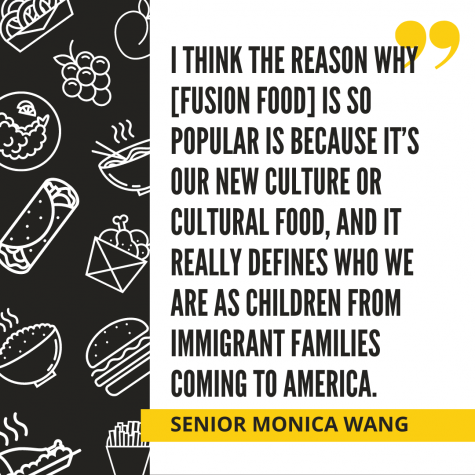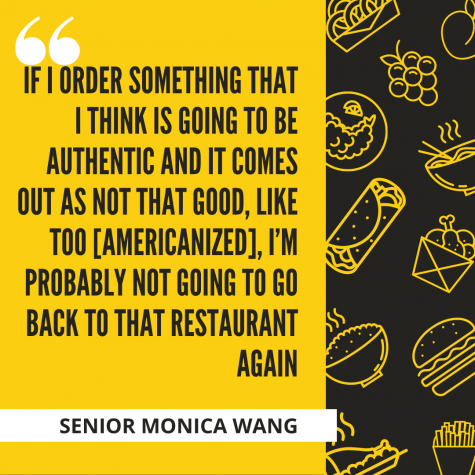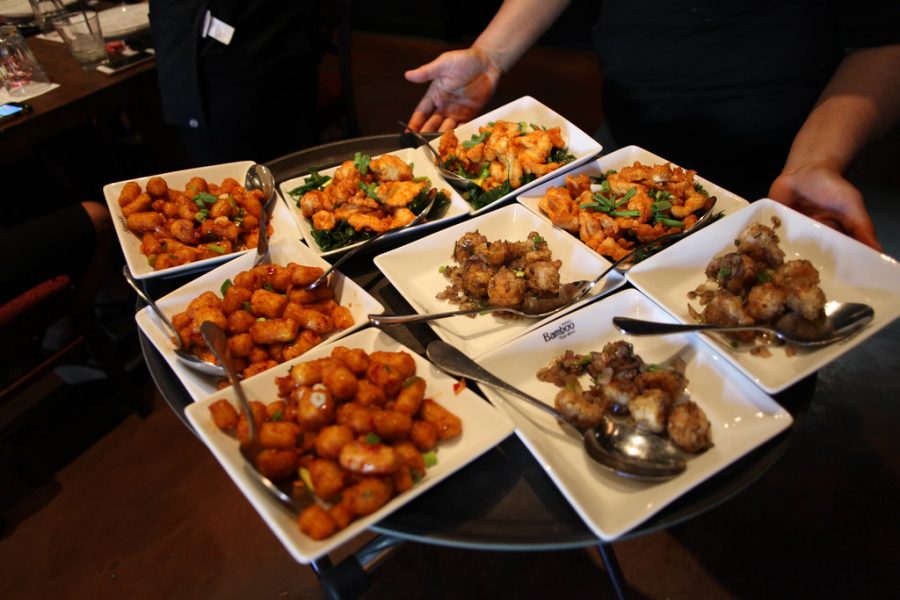The best of both worlds
MVHS students share their experiences with fusion food
“YEE: Heading Far East for a Feast at Inchin’s Bamboo Garden” by Yelp.com is licensed under CC BY-NC-ND 2.0
June 2, 2021
Senior Monica Wang says she comes from a family with “special taste buds.” Her paternal grandmother used to be a chef in an oceanside restaurant in China, and relatives on her father’s side own their own establishment. Wang attributes her good cooking skills to her father and her grandmother, and believes she has inherited their unique food preferences, which pushes her to create a variety of her own dishes.
“I’m the only one in my [immediate] family who doesn’t really, really like Chinese food,” Wang said. “So I’m always the one looking for new options and combining those options to make my own food because I am quite a picky eater. If there’s a [dish] that’s not up to my standards or I just don’t like it, I’m probably going to make my own food.”
As a result, Wang creates homemade fusion cuisine by combining several cuisines to make dishes that suit her own tastes. Despite having limited kitchen resources at home, she enjoys integrating elements of Chinese, Japanese and Korean cuisine with aspects of American food. Since American food is oilier and heavier, Wang offsets it with Asian dishes that are lighter on the stomach — in the past, she says she has made a traditional Japanese dish called katsudon more Western by adding oils and spices.
In terms of the popularity of Asian fusion food in the Bay Area, Wang says it likely stems from the area’s prominent young Asian American population.
“I think the reason why [fusion food] is so popular is because it’s our new culture or cultural food, and it really defines who we are as children from immigrant families coming to America,” Wang said. “I think this food really speaks to some people because a lot of people are like me, they don’t really like Asian food, but they don’t really love American food, so we’re just combining it to fit our own interests.”

Like Wang, sophomore Darpan Singh believes that the Bay Area’s diversity has allowed for the expansion of fusion cuisines and restaurants, and represents the many immigrants who live here. He says the “mix of cultures” allows for people to experiment with combining different cuisines.
In the past, Singh has had Indian food on pizza — a fusion of Indian and Italian cultures — and has also eaten at Inchin’s Bamboo Garden, an Indochinese chain restaurant. While he finds himself enjoying fusion dishes most of the time, he observes that some customers may be put off by the combinations of different types of food. For example, Singh believes that many people in the US aren’t accustomed to certain spice levels incorporated into Asian dishes, which can discourage people from trying an Asian American fusion dish.
Meanwhile, sophomore Saket Chodavarapu believes that creating a fusion dish out of two or more cuisines often produces something even better. Chodavarapu’s most memorable experiences with such foods have been an Indian-Italian combination with Indian spices and condiments on pizza, as well as sushi tacos from a hotel buffet meal.
“I like [sushi], but I’m not crazy about it,” Chodavarapu said. “The sushi and the tacos – they’re not bad, but they’re not great. But together, it was actually really good. I feel like each dish brings out the best in the other one.”
Chodavarapu views fusion foods as something that everyone can enjoy, because combining cuisines is like “bringing together the people who eat that [first] type of cuisine with the people who eat the second type, as well as another group of people who want to try something new.”
Chodavarapu also agrees with Wang and Singh that the diversity in the Bay Area has contributed to the popularity of fusion dishes. He says that because people know what they like within their own culture’s cuisine, when exposed to a multitude of other cuisines people take the liberty of putting the best of each together for blended, yet sometimes better outcomes.
While Chodavarapu sees the integration of different cuisines as a combination process, Wang views the breakdown of a fusion dish in a more technical sense, and chalks down a person’s preference to a ratio between the cuisines within a dish.
“Golden ratios differ from person to person just based on how they were raised,” Wang said. “If you were raised in a more traditional household, you probably like a restaurant that is less American-y and more traditional. But if you’re like me… I’ve been exposed to a decent amount of traditional food, but I also like some aspects of American food, so I probably like my [food] 50-50.”
Wang has also seen a spread of Asian and American mixed dishes through social media – primarily dessert dishes. For example, she cites Somi Somi, a restaurant that markets Korean desserts and soft serve ice cream, and which she has seen gain popularity amongst her peers. She adds that these social media accounts and pages tend to showcase the more American aspects of the food presented to avoid “culture shocks” – the shocking differences of other cultures in comparison to what someone may be accustomed to – over food on social media.

But Wang says that when she tries fusion food, authenticity is still a vital aspect to consider. If that’s lacking, she describes being unable to appreciate the overall food.
“If I order something that I think is going to be authentic and it comes out as not that good, like too [Americanized], I’m probably not going to go back to that restaurant again,” Wang said. “Or I might order something different the next time I go.”
In contrast, Singh views fusion food as more of a cuisine to enjoy on occasion. But as a default, he prefers food from a singular cuisine.
“Sometimes I just want to have something I’ve had before, or something I’m comfortable with,” Singh said. “But when I’m in the mood to try something new, then fusion food works out really well.”


















